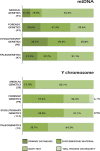When data sharing gets close to 100%: what human paleogenetics can teach the open science movement
- PMID: 25799293
- PMCID: PMC4370607
- DOI: 10.1371/journal.pone.0121409
When data sharing gets close to 100%: what human paleogenetics can teach the open science movement
Abstract
This study analyzes data sharing regarding mitochondrial, Y chromosomal and autosomal polymorphisms in a total of 162 papers on ancient human DNA published between 1988 and 2013. The estimated sharing rate was not far from totality (97.6% ± 2.1%) and substantially higher than observed in other fields of genetic research (evolutionary, medical and forensic genetics). Both a questionnaire-based survey and the examination of Journals' editorial policies suggest that this high sharing rate cannot be simply explained by the need to comply with stakeholders requests. Most data were made available through body text, but the use of primary databases increased in coincidence with the introduction of complete mitochondrial and next-generation sequencing methods. Our study highlights three important aspects. First, our results imply that researchers' awareness of the importance of openness and transparency for scientific progress may complement stakeholders' policies in achieving very high sharing rates. Second, widespread data sharing does not necessarily coincide with a prevalent use of practices which maximize data findability, accessibility, useability and preservation. A detailed look at the different ways in which data are released can be very useful to detect failures to adopt the best sharing modalities and understand how to correct them. Third and finally, the case of human paleogenetics tells us that a widespread awareness of the importance of Open Science may be important to build reliable scientific practices even in the presence of complex experimental challenges.
Conflict of interest statement
Figures





References
-
- Boulton G, Campbell P, Collins B, Elias P, Hall W, Laurie G, et al. Science as an open enterprise. London: The Royal Society; 2012.
-
- Borgman CL. The conundrum of sharing research data. J Am Soc Inf Sci Technol. 2012;63: 1059‐1078.
Publication types
MeSH terms
Substances
LinkOut - more resources
Full Text Sources
Other Literature Sources

